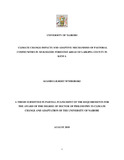| dc.description.abstract | In the forested pastoral ecosystems of Kenya, as elsewhere in Africa, traditional pastoralists‟ social, political and ecological systems are undergoing profound transformation due to climate variability and subsequent adaptive measures. This study was undertaken in Mukogodo forested ecosystem of Laikipia County among the Yaaku community. The general objective of the study was to understand and document the courses of resilience of the pastoral communities to the impacts of climate change and how the community used local adaptive responses. The Yaaku community in Mukogodo forested ecosystem of Laikipia County was studied to appreciate and document the climate change and adaptation measures. They were studied by collecting climate data at county and national meteorological stations. Additionally, the researcher conducted surveys to characterize household assets which gave the effects of climate variability as manifested by land use change and quantified by coping strategies. A simple random sampling method was used where 30 percent of the households in each of the nine villages were selected. The selection of households was by stratified random method of odd numbers from a list of Yaaku households guided by the initial participatory community managed disaster and risk reduction (CMDRR) activity done within the study community. A structured questionnaire was administered to 240 household heads or their representatives within the nine villages. The study also used Focus Group Discussions (FGD), and Key Informants (KI) interviews to help in the triangulation of the data. The study applied a combination of qualitative and quantitative approaches and analysed the data gathered, of which climate variability data were analysed by trend analysis. Land use and management data gathered by remote sensing were analysed by computer software (Erdas Imagine 2014) and classified images were keyed into maps composition by ArGIS to give the land use trends from 1984 to 2014. The study site was visualised by Google Earth and ground visits. Household survey data were analysed by use of Statistical Package for Social Sciences (IBM SPSS statistic 20). The FGD, ocular (photos) and KIs were analysed by context. The CMDRR data were analysed by pair-wise ranking and percentages. From the data it was evident that there was a decreased rainfall, while the temperatures increased over the period. However the variability in climate (rainfall and temperatures) had contributed to the change in land use and management of the pastoral forested ecosystem of Mukogodo in which there were decrease of grassland, forest, and increase in bare land and increase of shrub land, riverbed vegetation and agriculture cover in the last three decades. This change has affected Mukogodo forested ecosystem which became bush land instead of a forest. The main five hazards which contributed to vulnerability to climate change were drought, human conflict, human diseases, human wildlife conflict, and livestock diseases. These hazards were quantified and adaptation responses documented in form of disaster risk reduction plan for preparedness and among these are contingency plans for emergency. Therefore in order for the community to implement the plans two committees, one per location with representation of members from the nine villages were formed. The study found that political will coupled with community traditional adaptation strategies (social capital) addressed most of the impacts of climate change. It was therefore concluded that in order to have climate change adaptation measures in pastoral community in forested ecosystem in African or developing world, consideration of political influence is paramount. This is because the political sphere seemed to be the main delivery of adaptation | en_US |



